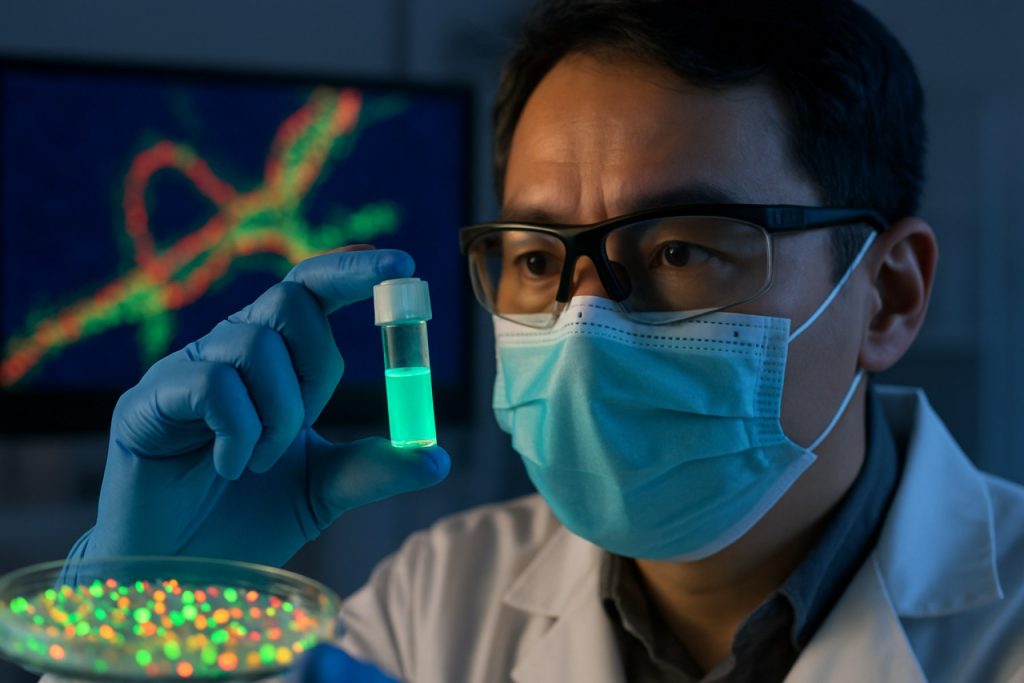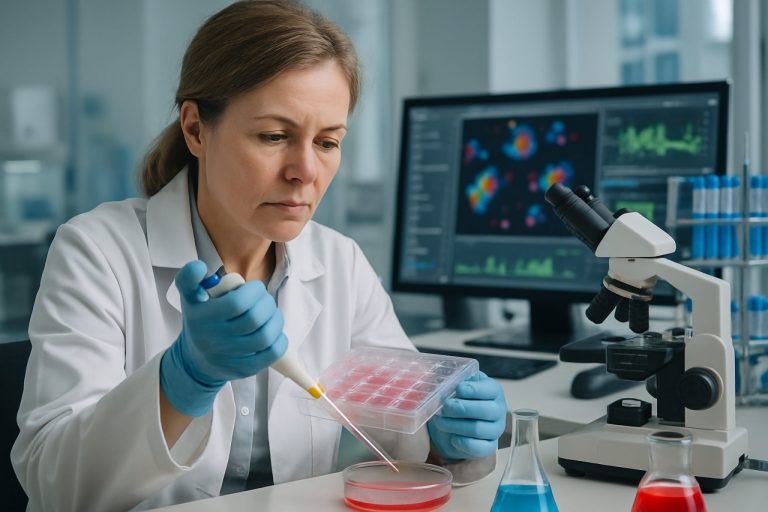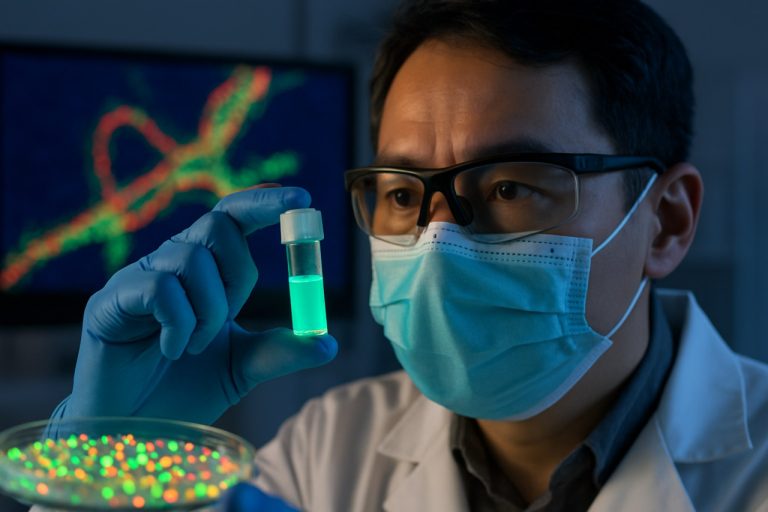
Quantum Dot-Based Biophotonics in 2025: Unleashing Next-Gen Imaging, Diagnostics, and Sensing. Explore How Quantum Dots Are Transforming Biophotonics and Driving Double-Digit Market Growth.
- Executive Summary: Quantum Dots Reshape Biophotonics
- Market Size & Forecast (2025–2030): 18% CAGR and Key Drivers
- Technology Overview: Quantum Dot Fundamentals in Biophotonics
- Key Applications: Imaging, Diagnostics, and Biosensing
- Competitive Landscape: Leading Companies and Innovators
- Recent Breakthroughs: Materials, Synthesis, and Integration
- Regulatory and Safety Considerations in Biophotonics
- Challenges: Scalability, Cost, and Biocompatibility
- Emerging Trends: AI Integration, Multiplexing, and Miniaturization
- Future Outlook: Strategic Opportunities and Roadmap to 2030
- Sources & References
Executive Summary: Quantum Dots Reshape Biophotonics
Quantum dot-based biophotonics is rapidly transforming the landscape of biomedical imaging, diagnostics, and therapeutic applications as of 2025. Quantum dots (QDs)—semiconductor nanocrystals with size-tunable optical properties—offer exceptional brightness, photostability, and multiplexing capabilities compared to traditional organic dyes and fluorescent proteins. These advantages are driving their integration into next-generation biophotonic tools, with significant momentum from both established industry leaders and innovative startups.
In 2025, the adoption of quantum dots in biophotonics is most prominent in high-sensitivity in vitro diagnostics, single-molecule imaging, and multiplexed biomarker detection. Companies such as Thermo Fisher Scientific and Merck KGaA (operating as MilliporeSigma in the US and Canada) are at the forefront, offering a range of quantum dot reagents and conjugates for research and clinical applications. Thermo Fisher Scientific’s Qdot™ nanocrystals, for example, are widely used in immunofluorescence and flow cytometry, enabling simultaneous detection of multiple targets with minimal spectral overlap.
Recent years have seen a surge in the development of heavy-metal-free quantum dots, such as indium phosphide (InP) and silicon-based nanocrystals, addressing regulatory and environmental concerns associated with cadmium-based materials. Nanosys, a leading quantum dot manufacturer, has expanded its portfolio to include cadmium-free QDs, supporting the growing demand for safer and more sustainable biophotonic solutions. Similarly, Nagase & Co., Ltd. is investing in scalable production of eco-friendly quantum dots for life science applications.
On the clinical front, quantum dot-based assays are being evaluated for early cancer detection, infectious disease diagnostics, and real-time intraoperative imaging. The unique optical signatures of QDs enable highly sensitive detection of low-abundance biomarkers, with several pilot studies underway in collaboration with academic medical centers and industry partners. The next few years are expected to see further progress toward regulatory approval and commercialization of QD-enabled diagnostic kits and imaging agents.
Looking ahead, the convergence of quantum dot technology with microfluidics, artificial intelligence, and wearable biosensors is poised to unlock new frontiers in personalized medicine and point-of-care diagnostics. As manufacturing processes mature and regulatory pathways clarify, quantum dot-based biophotonics is set to become a cornerstone of precision healthcare, with major contributions from global players such as Thermo Fisher Scientific, Merck KGaA, Nanosys, and Nagase & Co., Ltd..
Market Size & Forecast (2025–2030): 18% CAGR and Key Drivers
The global market for quantum dot-based biophotonics is poised for robust expansion, with forecasts indicating a compound annual growth rate (CAGR) of approximately 18% from 2025 through 2030. This growth trajectory is underpinned by a confluence of technological advancements, increasing adoption in biomedical imaging, diagnostics, and therapeutics, and the ongoing integration of quantum dots (QDs) into next-generation biophotonic devices.
Key drivers fueling this market include the superior optical properties of quantum dots—such as high brightness, tunable emission wavelengths, and exceptional photostability—making them highly attractive for applications in fluorescence imaging, multiplexed diagnostics, and targeted drug delivery. The demand for more sensitive and specific diagnostic tools in oncology, infectious diseases, and neurology is accelerating the adoption of QD-based probes and contrast agents in both research and clinical settings.
Major industry players are actively scaling up production and refining QD synthesis to meet biocompatibility and regulatory requirements. Nanoco Group plc, a UK-based pioneer, is expanding its portfolio of heavy-metal-free quantum dots, which are increasingly favored for biomedical applications due to their reduced toxicity. Thermo Fisher Scientific Inc. continues to offer a broad range of QD-based reagents and kits for life science research, supporting the growing demand for multiplexed imaging and flow cytometry. Ocean Technology Group and Sigma-Aldrich (now part of Merck KGaA) are also notable suppliers, providing quantum dot materials and custom solutions for research and development in biophotonics.
The market outlook is further strengthened by increasing investments in healthcare infrastructure and precision medicine, particularly in North America, Europe, and parts of Asia-Pacific. Governmental and institutional funding for advanced diagnostic technologies is expected to catalyze further adoption of QD-based biophotonic tools. Additionally, collaborations between quantum dot manufacturers and medical device companies are anticipated to accelerate the translation of laboratory innovations into commercial products.
Looking ahead, the period from 2025 to 2030 will likely see the emergence of new QD formulations with enhanced biocompatibility and functionalization, enabling broader clinical use. The convergence of quantum dot technology with artificial intelligence and microfluidics is also expected to open new frontiers in point-of-care diagnostics and personalized medicine. As regulatory pathways become clearer and manufacturing processes mature, quantum dot-based biophotonics is set to become a cornerstone of next-generation biomedical imaging and therapy.
Technology Overview: Quantum Dot Fundamentals in Biophotonics
Quantum dots (QDs) are semiconductor nanocrystals with unique optical and electronic properties, making them highly attractive for biophotonic applications. Their size-tunable emission, high quantum yield, and photostability distinguish them from traditional organic dyes and fluorescent proteins. In biophotonics, QDs are primarily used for imaging, sensing, and diagnostic applications, leveraging their ability to emit bright, narrow, and multiplexed fluorescence signals under single-wavelength excitation.
The core structure of a quantum dot typically consists of a semiconductor material such as CdSe, InP, or perovskite compounds, often encapsulated with a shell (e.g., ZnS) to enhance stability and quantum efficiency. Surface functionalization with biomolecules enables targeted binding to specific cells or biomolecules, a critical feature for in vivo imaging and biosensing. Recent advances have focused on developing heavy-metal-free QDs, such as indium phosphide (InP) and silicon-based nanocrystals, to address toxicity concerns and regulatory requirements for clinical translation.
In 2025, the field is witnessing rapid progress in the synthesis and surface engineering of QDs for biophotonic use. Companies like Thermo Fisher Scientific and Ocean NanoTech are commercializing a range of QD conjugates for multiplexed bioimaging, flow cytometry, and immunoassays. Thermo Fisher Scientific’s Qdot™ nanocrystals, for example, are widely used in research laboratories for their brightness and stability, supporting applications from single-molecule tracking to tissue imaging.
Emerging QD technologies are also being integrated into point-of-care diagnostic devices. Nanoco Group is advancing cadmium-free QDs for biosensing platforms, aiming to meet both performance and environmental safety standards. Meanwhile, Nanosys and Novaled are developing QD materials with improved biocompatibility and emission tunability, which are expected to expand the range of detectable biomarkers and enable more sensitive multiplexed assays.
Looking ahead, the next few years are expected to bring further improvements in QD synthesis, with a focus on scalable, reproducible, and environmentally benign production methods. Advances in surface chemistry will enhance the specificity and stability of QD-bioconjugates, facilitating their adoption in clinical diagnostics and therapeutic monitoring. As regulatory frameworks evolve, particularly around heavy-metal content, the adoption of non-toxic QDs is likely to accelerate, paving the way for broader clinical and commercial deployment in biophotonics.
Key Applications: Imaging, Diagnostics, and Biosensing
Quantum dot-based biophotonics is rapidly advancing, with 2025 poised to see significant growth in applications across imaging, diagnostics, and biosensing. Quantum dots (QDs), semiconductor nanocrystals with unique optical properties such as size-tunable emission and high photostability, are increasingly being integrated into biomedical workflows due to their superior performance over traditional organic dyes.
In medical imaging, QDs are enabling higher sensitivity and multiplexing capabilities. Their narrow emission spectra and broad absorption profiles allow simultaneous detection of multiple biomarkers, which is particularly valuable in cancer diagnostics and intraoperative imaging. Companies like Thermo Fisher Scientific and Merck KGaA (operating as MilliporeSigma in the US and Canada) are actively developing and supplying QD-based reagents and kits for research and preclinical imaging. These products are being adopted in advanced fluorescence microscopy and flow cytometry, where the need for precise, multi-color labeling is critical.
In diagnostics, QDs are being incorporated into point-of-care (POC) assays and lateral flow tests, offering enhanced sensitivity and quantitative readouts. For example, Nanoco Group specializes in heavy-metal-free quantum dots, addressing toxicity concerns and paving the way for safer clinical applications. Their materials are being evaluated for use in immunoassays and molecular diagnostics, where rapid and accurate detection of pathogens or disease markers is essential. The integration of QDs into diagnostic platforms is expected to accelerate, especially as regulatory frameworks for nanomaterials in healthcare become clearer in the next few years.
Biosensing is another area where QDs are making a substantial impact. Their high surface-to-volume ratio and customizable surface chemistry enable the development of highly specific and sensitive biosensors. Companies such as Ocean Insight are leveraging QDs in optical biosensing platforms for environmental monitoring and food safety, in addition to biomedical applications. These sensors can detect low concentrations of analytes, making them valuable for early disease detection and real-time monitoring.
Looking ahead, the outlook for quantum dot-based biophotonics is robust. Ongoing improvements in QD synthesis, biocompatibility, and functionalization are expected to drive broader adoption in clinical and research settings. As leading manufacturers continue to scale up production and address regulatory and safety challenges, quantum dot-enabled imaging, diagnostics, and biosensing are set to become integral components of next-generation healthcare technologies through 2025 and beyond.
Competitive Landscape: Leading Companies and Innovators
The competitive landscape for quantum dot-based biophotonics in 2025 is characterized by a dynamic mix of established multinational corporations, specialized nanomaterials manufacturers, and innovative startups. These entities are driving advancements in quantum dot synthesis, surface functionalization, and integration into biophotonic devices for applications such as bioimaging, diagnostics, and biosensing.
Among the global leaders, Thermo Fisher Scientific continues to play a pivotal role, leveraging its extensive portfolio of quantum dot reagents and conjugates for life science research. The company’s Qdot™ nanocrystals are widely used in multiplexed fluorescence imaging and flow cytometry, and recent product updates have focused on improved photostability and biocompatibility. Thermo Fisher Scientific also collaborates with academic and clinical partners to accelerate translational research in molecular diagnostics.
Another major player, Merck KGaA (operating as MilliporeSigma in the US and Canada), supplies a broad range of quantum dot materials and surface modification chemistries. The company’s focus in 2025 includes scaling up production of heavy-metal-free quantum dots, addressing regulatory and environmental concerns associated with cadmium-based materials. Merck KGaA is also investing in partnerships to integrate quantum dots into next-generation point-of-care diagnostic platforms.
In Asia, Nanosys, Inc. stands out for its proprietary quantum dot synthesis technologies, which have been adapted for both display and biophotonic applications. The company’s recent efforts include the development of high-quantum-yield, non-toxic quantum dots tailored for in vitro and in vivo imaging. Nanosys, Inc. is actively collaborating with medical device manufacturers to commercialize quantum dot-enabled biosensors.
Startups and university spin-offs are also shaping the sector. Ocean Team and Nanoco Group plc are notable for their work on cadmium-free quantum dots and scalable manufacturing processes. Nanoco Group plc has secured partnerships with diagnostic companies to supply quantum dots for immunoassays and lateral flow tests, aiming to enhance sensitivity and multiplexing capabilities.
Looking ahead, the competitive landscape is expected to intensify as regulatory frameworks evolve and demand for safer, more robust quantum dot formulations grows. Companies with strong intellectual property portfolios, scalable production, and established partnerships in the biomedical sector are likely to maintain a competitive edge. Strategic collaborations between material suppliers, device manufacturers, and clinical end-users will be crucial for translating quantum dot-based biophotonics from research to routine clinical practice in the coming years.
Recent Breakthroughs: Materials, Synthesis, and Integration
Quantum dot-based biophotonics has witnessed significant advancements in recent years, particularly in the development of novel materials, improved synthesis techniques, and enhanced integration strategies for biomedical applications. As of 2025, the field is characterized by a shift towards environmentally benign and highly tunable quantum dots (QDs), with a strong emphasis on clinical translation and commercial scalability.
A major breakthrough has been the emergence of heavy-metal-free quantum dots, such as those based on indium phosphide (InP) and silicon, which address toxicity concerns associated with traditional cadmium- or lead-based QDs. Companies like Nanosys and Novaled have been at the forefront of developing and commercializing these next-generation QDs, focusing on both display and biophotonic applications. These materials offer high quantum yields, narrow emission spectra, and improved biocompatibility, making them suitable for in vivo imaging and diagnostic assays.
On the synthesis front, recent years have seen the adoption of continuous-flow microreactor technologies, enabling precise control over QD size, composition, and surface chemistry. This approach, championed by companies such as Avantama, allows for scalable and reproducible production of QDs with tailored optical properties. Surface engineering techniques, including advanced ligand exchange and encapsulation strategies, have further enhanced the stability and functionalization of QDs for targeted biophotonic applications.
Integration of QDs into biophotonic platforms has also progressed rapidly. For instance, Thermo Fisher Scientific continues to expand its portfolio of QD-based probes for multiplexed fluorescence imaging, flow cytometry, and biosensing. These products leverage the unique optical signatures of QDs to enable simultaneous detection of multiple biomarkers with high sensitivity and specificity. Additionally, collaborations between QD manufacturers and medical device companies are accelerating the development of QD-enabled point-of-care diagnostics and wearable biosensors.
Looking ahead, the next few years are expected to bring further integration of QDs with emerging photonic technologies, such as microfluidic chips and optoelectronic devices, to create compact, high-throughput diagnostic platforms. The ongoing refinement of synthesis and surface modification methods will likely yield QDs with even greater biocompatibility and functional versatility, paving the way for regulatory approval and broader clinical adoption. As the ecosystem matures, partnerships between material innovators, device manufacturers, and healthcare providers will be crucial in translating quantum dot-based biophotonics from the laboratory to real-world medical settings.
Regulatory and Safety Considerations in Biophotonics
Quantum dot-based biophotonics is rapidly advancing, with applications ranging from in vitro diagnostics to in vivo imaging and targeted drug delivery. However, the unique properties of quantum dots (QDs)—notably their nanoscale size, tunable emission spectra, and composition, often involving heavy metals such as cadmium or lead—raise significant regulatory and safety considerations. As of 2025, regulatory frameworks are evolving to address these challenges, with a focus on both product efficacy and patient safety.
In the United States, the U.S. Food and Drug Administration (FDA) continues to oversee the approval of QD-based medical devices and diagnostics under its existing medical device and drug regulations. The FDA requires comprehensive preclinical data on toxicity, biodistribution, and clearance, especially for QDs containing potentially hazardous elements. The agency has issued guidance on nanomaterials in medical products, emphasizing the need for detailed characterization and risk assessment. In the European Union, the European Medicines Agency (EMA) and the European Commission are similarly updating their frameworks to address nanomaterial-specific risks, with the Medical Device Regulation (MDR) and In Vitro Diagnostic Regulation (IVDR) now explicitly referencing nanomaterials.
Major manufacturers such as Thermo Fisher Scientific and Merck KGaA (operating as MilliporeSigma in the U.S. and Canada) are actively engaged in developing QD-based reagents and kits for research and clinical use. These companies are investing in surface modification technologies to improve biocompatibility and reduce toxicity, such as encapsulating QDs in inert shells or using cadmium-free alternatives. For example, Thermo Fisher Scientific offers Qdot nanocrystals with various surface coatings to enhance stability and minimize leaching of toxic ions.
Safety concerns remain a central focus, particularly regarding the long-term fate of QDs in vivo. Regulatory agencies are closely monitoring emerging data on the pharmacokinetics and potential accumulation of QDs in organs. The next few years are expected to see increased requirements for post-market surveillance and real-world evidence collection, especially as QD-based products move from research to clinical settings.
Looking ahead, the regulatory landscape is likely to become more harmonized internationally, with organizations such as the International Organization for Standardization (ISO) working on standards for nanomaterial characterization and safety testing. The industry outlook for 2025 and beyond suggests that while regulatory hurdles remain, ongoing innovation in QD chemistry and encapsulation, coupled with clearer regulatory pathways, will support the safe and effective integration of quantum dot-based biophotonics into mainstream healthcare.
Challenges: Scalability, Cost, and Biocompatibility
Quantum dot-based biophotonics has emerged as a transformative technology in biomedical imaging, diagnostics, and therapeutics. However, as the field moves into 2025 and beyond, several critical challenges remain—particularly in the areas of scalability, cost, and biocompatibility.
Scalability is a persistent hurdle for quantum dot (QD) production. While laboratory-scale synthesis methods have matured, translating these processes to industrial-scale manufacturing with consistent quality and reproducibility is complex. Companies such as Nanosys and Nanoco Group are among the few that have developed scalable production lines for QDs, primarily for display and lighting applications. However, the stringent purity and surface chemistry requirements for biomedical use are even more demanding. In 2025, efforts are ongoing to adapt continuous-flow synthesis and automated purification systems to meet the high standards required for clinical-grade QDs, but widespread adoption is still limited by technical and regulatory barriers.
Cost remains a significant barrier to the broader adoption of QD-based biophotonics. The high price of raw materials, such as cadmium, indium, and tellurium, as well as the need for precise synthesis and surface modification, contribute to elevated production costs. While companies like Nanosys have made progress in reducing costs for consumer electronics, the additional requirements for medical-grade QDs—such as rigorous purification and functionalization—keep prices high for biomedical applications. As of 2025, the cost per milligram of high-quality, biocompatible QDs remains several times higher than that of traditional organic dyes or fluorescent proteins, limiting their use to specialized research and high-value clinical diagnostics.
Biocompatibility is perhaps the most critical challenge for QD-based biophotonics. Many high-performance QDs contain heavy metals like cadmium or lead, raising concerns about toxicity and environmental impact. In response, companies such as Nanoco Group have developed cadmium-free QDs based on indium phosphide, which are being evaluated for their safety and performance in biological systems. Additionally, surface engineering—such as encapsulation with biocompatible polymers or silica—has shown promise in reducing cytotoxicity and improving stability in physiological environments. Nevertheless, comprehensive long-term toxicity studies and regulatory approvals are still in progress as of 2025, and the use of QDs in human clinical applications remains largely experimental.
Looking ahead, the outlook for overcoming these challenges is cautiously optimistic. Advances in green synthesis, automation, and surface chemistry are expected to improve scalability and reduce costs. Meanwhile, the development of non-toxic, heavy-metal-free QDs and robust biocompatible coatings is likely to accelerate regulatory acceptance. However, widespread clinical adoption will depend on continued collaboration between industry leaders, such as Nanosys and Nanoco Group, and regulatory agencies to ensure safety, efficacy, and affordability in real-world biomedical settings.
Emerging Trends: AI Integration, Multiplexing, and Miniaturization
Quantum dot-based biophotonics is rapidly evolving, with 2025 poised to see significant advances driven by three converging trends: artificial intelligence (AI) integration, multiplexed detection, and device miniaturization. These trends are reshaping both research and commercial applications, particularly in diagnostics, imaging, and point-of-care testing.
AI integration is accelerating the analysis and interpretation of complex biophotonic data generated by quantum dot (QD) systems. Quantum dots, with their tunable emission spectra and high photostability, produce large, information-rich datasets in multiplexed assays and imaging. AI algorithms, especially deep learning, are now being embedded into QD-based platforms to automate signal deconvolution, pattern recognition, and quantitative analysis. For example, companies like Thermo Fisher Scientific and Carl Zeiss AG are developing AI-powered imaging systems that leverage QD probes for enhanced sensitivity and throughput in cellular and tissue analysis. These systems are expected to reduce human error, increase diagnostic accuracy, and enable real-time decision-making in clinical and research settings.
Multiplexing—the simultaneous detection of multiple biomarkers or analytes—remains a core advantage of QD-based biophotonics. The unique optical properties of QDs, such as narrow emission peaks and broad excitation profiles, allow for the design of highly multiplexed assays. In 2025, commercial platforms are expanding the number of detectable targets per assay, with some systems capable of analyzing dozens of biomarkers in a single run. Invitrogen (a brand of Thermo Fisher Scientific) and Nanoco Group plc are among the companies advancing QD multiplexing technologies for applications in cancer diagnostics, infectious disease panels, and personalized medicine. This trend is expected to drive the adoption of QD-based assays in clinical laboratories and decentralized testing environments.
Miniaturization is another key trend, as demand grows for portable, user-friendly biophotonic devices. Advances in microfluidics, integrated optics, and compact QD light sources are enabling the development of handheld or benchtop instruments for rapid diagnostics and field-based testing. Companies such as Thermo Fisher Scientific and Carl Zeiss AG are investing in miniaturized QD-based platforms, targeting applications ranging from infectious disease screening to environmental monitoring. These devices are expected to democratize access to advanced diagnostics, particularly in resource-limited settings.
Looking ahead, the convergence of AI, multiplexing, and miniaturization is set to transform quantum dot-based biophotonics, making it more accessible, scalable, and impactful across healthcare and life sciences. As regulatory pathways clarify and manufacturing processes mature, the next few years will likely see broader clinical adoption and the emergence of new use cases beyond traditional laboratory environments.
Future Outlook: Strategic Opportunities and Roadmap to 2030
The future outlook for quantum dot-based biophotonics through 2025 and into the next several years is marked by rapid technological maturation, expanding commercial adoption, and strategic positioning by key industry players. Quantum dots (QDs), with their tunable emission spectra, high brightness, and photostability, are increasingly central to innovations in bioimaging, diagnostics, and therapeutic monitoring. As the biophotonics sector seeks higher sensitivity and multiplexing capabilities, QDs are poised to address critical unmet needs in both research and clinical settings.
In 2025, the integration of QDs into advanced imaging platforms is accelerating, driven by collaborations between quantum dot manufacturers and medical device companies. For example, Thermo Fisher Scientific continues to expand its Invitrogen Qdot product line, offering a broad palette of QDs for multiplexed fluorescence imaging and flow cytometry. These products are widely adopted in academic and clinical research, supporting applications from single-cell analysis to in vivo imaging. Similarly, Merck KGaA (operating as MilliporeSigma in the US and Canada) is investing in scalable QD synthesis and surface modification technologies, aiming to improve biocompatibility and regulatory compliance for clinical use.
Strategic partnerships are also shaping the roadmap to 2030. Companies such as Nanosys, a leading QD manufacturer, are exploring collaborations with biotechnology firms to develop next-generation diagnostic assays and point-of-care devices. The focus is on leveraging QDs’ multiplexing capabilities to enable simultaneous detection of multiple biomarkers, which is critical for early disease detection and personalized medicine. Meanwhile, Avantama is advancing heavy-metal-free QD formulations, addressing environmental and safety concerns associated with traditional cadmium-based QDs, and positioning itself for regulatory shifts anticipated in the coming years.
Looking ahead, the roadmap to 2030 will likely be defined by several key trends:
- Continued miniaturization and integration of QD-based sensors into wearable and implantable devices, enabling real-time, continuous health monitoring.
- Expansion of QD applications in photodynamic therapy and targeted drug delivery, supported by ongoing research into QD-biomolecule conjugates.
- Regulatory harmonization and standardization efforts, as industry bodies and manufacturers work to ensure safety, reproducibility, and clinical efficacy of QD-enabled biophotonic tools.
- Increased investment in sustainable and non-toxic QD chemistries, with companies like Nanosys and Avantama at the forefront.
Overall, the strategic opportunities for quantum dot-based biophotonics are substantial, with the sector expected to see robust growth and transformative impact on healthcare diagnostics and therapeutics by 2030.
Sources & References
- Thermo Fisher Scientific
- Nagase & Co., Ltd.
- Ocean NanoTech
- Novaled
- Avantama
- European Medicines Agency
- International Organization for Standardization
- Carl Zeiss AG



